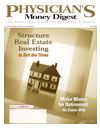Nearing Retirement? Cash Flow Is the Name of the Game
If you had money broadly diversifiedacross the domestic, international,and emerging markets,and spread among the differentasset classes this past year, youprobably enjoyed a nice return on yourinvestments. Longer term history hasshown us that the performance ofequities has surpassed that of othertypes of financial instruments. Butwhat if you are nearing retirement anddon't have either the time or fortitudeto ride out market volatility?
Through the Grapevine
When listening to some of the foremostauthorities concerning the anticipatedfuture performance of the stockmarket, investing in common stocksjust does not look all that exciting.Depending on who you listen to,longer term market rates of return of6% to 8% are bandied about. If thisturns out to be true, you have to askyourself the question, "Is subjectingmyself to the volatility inherent in thestock market justified for a 7% rate ofreturn?" If your answer is no, then youmay want to adjust your thinking andinvestment strategy accordingly.
In addition, we have been experiencingrising short-term interest rates,which will have a dampening effect onthe economy at some point. As such,you should use caution in selectingfixed-income instruments that haveintermediate to longer term maturities.Generally, if you are consideringinvesting in bonds or bond mutualfunds, stay with those instrumentswhose durations only extend out a fewyears to mitigate price volatility.
What about CDs? Well, dependingon the term of the CD, rates of 5% doexist, but do not come without restrictions.For example, a 2-year CD mayyield 5%, but if you require liquidity,tying up your money for 2 years maynot be wise as you will incur penaltiesshould you need to access moniesbefore the CD matures.
So, if the above-mentioned optionsare eliminated from the equationbecause of low yields and interest raterisk, and you are gun-shy of commonstocks, which appear to be risky in avolatile stock market, what might beanother alternative?
Consider Preferred Equities
Another option is to investigate preferredstocks in companies whose commonstock pays dividends. A preferredstock is often referred to as a "hybrid" security. It combines the features ofcommon stock and debt. This securityranks senior in claim to a firm's commonstock, and junior in claim to afirm's debt issues. The reason forchoosing preferred stocks in companieswhose common stocks pay dividends,is because dividends must bepaid in full on the preferred stockbefore the firm can pay any dividendsto shareholders of common stock.
However, preferred stock pricemovements behave somewhat likebonds in that as interest rates rise, thevalue of the preferred stock may fall.The magnitude of the fall will bedependent upon its stated yield, calldate, credit quality, and maturity date.However, preferred stocks generally donot experience the volatility that commonstocks do.
For example, let's consider Altria—the old Philip Morris—preferred stock(ticker symbol: PJW). It is callable bythe company in January 2008. Whymight Altria call this issue on or afterthis date? Well, if interest rates were todecline, then Altria might call the issuein order to refinance at a lower interestrate, which would save the companymoney. However, if rates climb, itmight not be in their best interest tocall the issue. In either case, the issuematures in January 2027, at whichpoint they must redeem it at $25. Thisinstrument is rated BBB by Standard& Poors, which is the lowest investment-grade designation. The call priceis $25 and the stated yield on the issueis 6.5% for an annual dividend paymentof $1.63. As of writing this article,Altria preferred is selling at$22.82. So, if you had purchasedAltria preferred at this price, your current(actual) yield would not be 6.5%,but $1.63 divided by $22.82, whichequals 7.12%.
Is It Worth the Risk?
Could Altria drop further than$22.82? Yes, it could, but by the sametoken, the price could also rise. In fact,the price could increase to $25 or evenpossibly more than $25—a premiumto its call or issue price. Being the "bottom-feeder" that I am, I look for thoseissues that are selling at a discount tothe call price.
So, if between now and the time theissue is called, the price of the stockclimbed back to its issue price of $25,the yield to call on Altria is above 12%.Why so high? Well let's analyze this. Ifyou bought Altria at $22.82, you wouldreceive your annual dividend of $1.63.But should the price rise to either $25 orbe called by the issue on or after the calldate at $25, then you will also realize acapital gain of $25 minus $22.82,which equals $2.18.
In this event, you will have receivednot only your dividend of $1.63, butalso a capital gain of $2.18 on a$23.55 investment. But even if the preferrednever goes back up to $25 and isnot called on or after its call date bythe issuer at $25, is a yield on aninvestment-grade security of 7% ormore such a bitter pill to swallow? No,I don't think so when you considershorter term bond yields, CDs, andmoney market accounts.
Goals Determine Strategy
The above-mentioned strategy is notnecessarily appropriate for someonemany years from retirement who is seekinglong-term growth of their assets—unless they are risk-averse and seeking topreserve capital. However, for the investornearing retirement who needs togenerate income as their primary objectivewith capital appreciation taking aback seat, then it may be worthwhile toinvestigate this type of strategy.
Thomas R. Kosky and his partner, Harris L.Kerker, are principals of the Asset Planning,Group, Inc, in Miami, Fla. The companyspecializes in investment, retirement, andestate planning. Mr. Kosky also teaches corporatefinance in the Saturday Executive and Health CareExecutive MBA Programs at the University of Miami in CoralGables, Fla. Mr. Kosky and Mr. Kerker welcome questions orcomments at 800-953-5508 or e-mail Mr. Kosky directly atProfessorKosky@aol.com.
